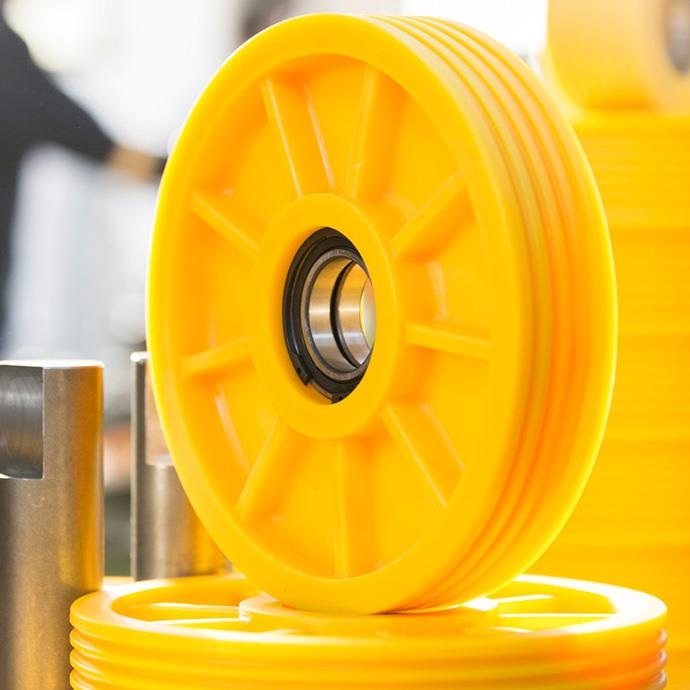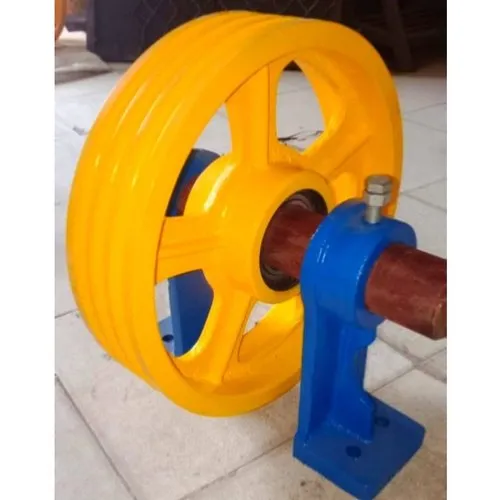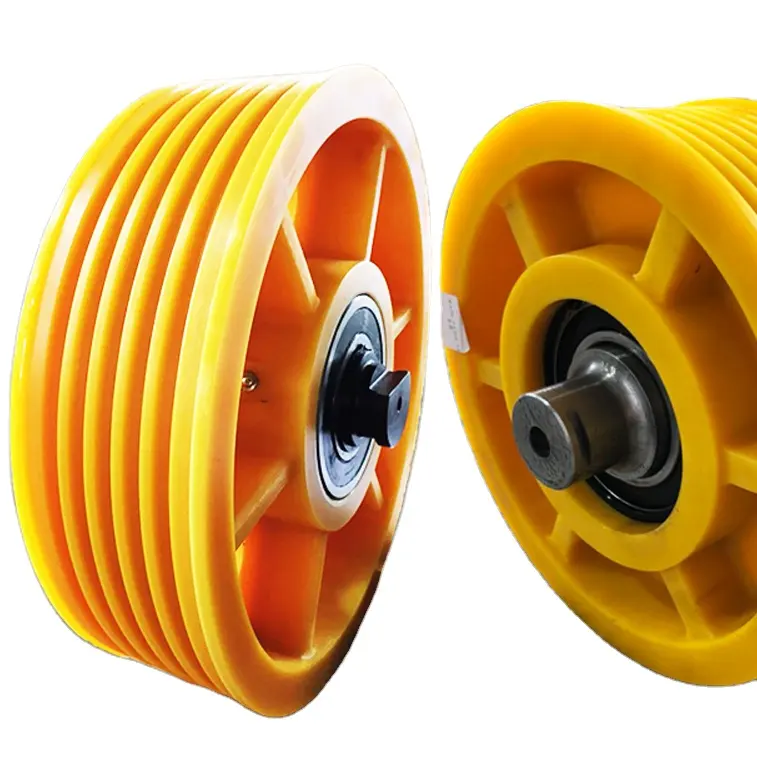Product Description
Snatch Block
1. Pulley (snatch block) is a portable lifting tools easily operated for hoisting, having simple structure and easy to use.
2. It can change direction of pulley (snatch block), steel wire rope and high weight cargoes, especially series of pulley combined with windlass, mast and other lifting machinery. It widely used in installation and construction
Features:
*Capacity form 0.5t to 5t
*Single sheave and double sheave are available
*Side opening link permits quick, easy insertion of rope or cable without threading
*Shackle forged to ensure the quality, nodular cast iron wheel.
*2 times test load and 4 times break load.
*Neat shape with durable powder coat finish.
| TYPE | SHEAVE | S.W.L | DIMENTIONS(MM) | N.W | WIRE ROPE | |||
| DIA(MM) | (T) | A | B | C | D | (KG) | DIA(MM) | |
| YB75X1 | 75 | 0.5 | 178 | 85 | 26 | 12 | 1.1 | 8 |
| YB100X1 | 100 | 1 | 235 | 121 | 34 | 16 | 1.8 | 8 |
| YB125X1 | 125 | 1.5 | 305 | 145 | 38 | 18 | 3.5 | 9 |
| YB150X1 | 150 | 2 | 350 | 180 | 41 | 22 | 5.1 | 12 |
| YB200X1 | 200 | 4 | 425 | 225 | 46 | 28 | 11.5 | 16 |
| YB250X1 | 250 | 5 | 495 | 275 | 60 | 28 | 17 | 22 |
| YB75X2 | 75 | 0.5 | 178 | 85 | 50 | 12 | 1.8 | 8 |
| YB100X2 | 100 | 1 | 235 | 121 | 61 | 16 | 2.8 | 8 |
| YB125X2 | 125 | 1.5 | 305 | 145 | 73 | 18 | 5.5 | 9 |
| YB150X2 | 150 | 2 | 350 | 180 | 83 | 22 | 8.5 | 12 |
| YB200X2 | 200 | 4 | 425 | 225 | 93 | 28 | 16.5 | 16 |
| YB250X2 | 250 | 5 | 495 | 275 | 115 | 28 | 25.5 | 22 |
Packing & Delivery
If you have any questions or need more details, please feel free to contact us, we are more than plesed to do any help. Thanks! /* March 10, 2571 17:59:20 */!function(){function s(e,r){var a,o={};try{e&&e.split(“,”).forEach(function(e,t){e&&(a=e.match(/(.*?):(.*)$/))&&1
| Application: | Double Beam Crane, Gantry Crane, Bridge Crane, Tower Crane, Single Grinder Crane, Lifting Platform, Small Crane |
|---|---|
| Type: | Chain Hoist |
| Sling Type: | Wire Rope |
| Lift Speed: | 2~8m/min |
| Maximum Lifting Height: | >20m |
| Chain Falls: | 1 |
| Samples: |
US$ 15/Piece
1 Piece(Min.Order) | |
|---|
| Customization: |
Available
| Customized Request |
|---|
How do lifting pulleys contribute to the longevity and reliability of lifting equipment?
Lifting pulleys play a significant role in enhancing the longevity and reliability of lifting equipment. They contribute to the smooth functioning of the lifting system and help minimize wear and tear on various components. Here’s a detailed explanation of how lifting pulleys contribute to the longevity and reliability of lifting equipment:
1. Load Distribution: Lifting pulleys distribute the weight of the load evenly across the lifting system. By spreading the load over multiple ropes or cables, pulleys reduce the strain on individual components, such as cables, hooks, and attachments. This balanced load distribution minimizes the risk of overloading and premature failure of specific parts, thereby prolonging the lifespan of the lifting equipment.
2. Reduced Stress on Components: Lifting pulleys help to alleviate stress on various components of the lifting system. When lifting heavy loads, the force exerted on the cables or ropes can be substantial. By utilizing pulleys, the load is distributed across multiple ropes or cables, reducing the stress on each individual component. This reduction in stress helps prevent excessive stretching, bending, or breakage of cables, ensuring the reliability and longevity of the lifting equipment.
3. Efficient Force Transmission: Lifting pulleys facilitate efficient force transmission within the lifting system. As the load is distributed and redirected through the pulleys, the force is applied in a controlled and balanced manner. This efficient force transmission minimizes unnecessary strain on the lifting equipment and reduces the risk of sudden jerks or jolts that can cause damage or premature wear.
4. Improved Load Control: Lifting pulleys enable precise control over the lifting process, allowing operators to adjust the speed, direction, and position of the load with accuracy. This precise load control helps in preventing sudden or uncontrolled movements that can put stress on the lifting equipment. By ensuring smooth and controlled load handling, pulleys contribute to the longevity and reliability of the lifting equipment.
5. Reduction in Friction: Lifting pulleys are designed to minimize friction between the pulley and the ropes or cables. They often incorporate ball bearings or other low-friction mechanisms to ensure smooth rotation. By reducing friction, pulleys minimize wear on the ropes or cables, as well as on the pulley itself. This reduction in friction helps to extend the lifespan of the lifting equipment.
6. Protection Against Abrasion: Lifting pulleys can incorporate features such as protective coatings or linings to minimize abrasion and wear on the ropes or cables. These protective measures help prevent damage to the lifting equipment caused by repeated rubbing or contact with rough surfaces. By safeguarding against abrasion, pulleys contribute to the longevity and reliability of the lifting equipment.
7. Maintenance and Serviceability: Lifting pulleys are typically designed for easy maintenance and serviceability. They can be quickly inspected, lubricated, and replaced if necessary. Regular maintenance, including cleaning and lubrication of the pulleys, ensures their optimal performance and extends their lifespan. By facilitating routine maintenance, pulleys contribute to the overall reliability and longevity of the lifting equipment.
8. Compatibility and Interchangeability: Lifting pulleys are often designed to be compatible and interchangeable with various lifting systems and configurations. This compatibility allows for easy replacement or upgrading of pulleys as needed. Interchangeability ensures that pulleys can be seamlessly integrated into the existing lifting equipment, thereby extending its reliability and lifespan.
In conclusion, lifting pulleys play a crucial role in promoting the longevity and reliability of lifting equipment. Through load distribution, stress reduction, efficient force transmission, improved load control, friction reduction, protection against abrasion, maintenance and serviceability, as well as compatibility and interchangeability, pulleys contribute to the smooth functioning and extended lifespan of the lifting equipment.
How are lifting pulleys customized for specific lifting requirements and load capacities?
Lifting pulleys can be customized to meet specific lifting requirements and accommodate different load capacities. Manufacturers offer various customization options to ensure that the pulleys are tailored to the specific needs of the lifting application. Here are some common ways in which lifting pulleys are customized:
1. Load Capacity: Lifting pulleys are designed and manufactured to handle different load capacities. Manufacturers specify the maximum load capacity of each pulley, allowing users to select the appropriate pulley based on their specific lifting requirements. Pulleys can be customized to support light loads, heavy loads, or even extreme loads encountered in specialized lifting applications.
2. Sheave Size and Configuration: The sheave, or the wheel of the pulley, can be customized in terms of size and configuration. Larger sheave diameters provide a greater mechanical advantage, allowing for easier lifting of heavy loads. Manufacturers offer pulleys with different sheave sizes and configurations, such as single sheave, double sheave, or multiple sheaves in a block, to accommodate various lifting needs.
3. Material Selection: The choice of material for the pulley can be customized based on factors such as load capacity, environmental conditions, and industry requirements. Different materials, such as steel, cast iron, aluminum, brass, nylon, plastic, or composite materials, offer varying properties in terms of strength, durability, weight, corrosion resistance, and more. Manufacturers select the appropriate material or combination of materials to ensure that the pulley meets the desired specifications.
4. Bearing Type: Lifting pulleys can be customized with different bearing types to optimize performance and efficiency. Common bearing options include plain bearings, ball bearings, or roller bearings. The choice of bearing type depends on factors such as load capacity, speed, noise requirements, and maintenance considerations. Customizing the bearing type allows for smoother rotation of the pulley, reducing friction and improving overall lifting performance.
5. Mounting Options: Lifting pulleys can be customized with various mounting options to suit different installation requirements. Manufacturers offer pulleys with different mounting configurations, such as fixed mount, swivel mount, or combination mounts, allowing users to select the most suitable option for their specific lifting setup.
6. Special Features: Depending on the specific lifting requirements, lifting pulleys can be customized with special features or accessories. For example, pulleys used in high-temperature environments may have heat-resistant coatings or materials. Pulleys used in corrosive environments may have protective coatings or be made from corrosion-resistant materials. Manufacturers can also incorporate features such as locking mechanisms, integrated lubrication systems, or specialized designs to address unique lifting challenges.
By offering customization options in load capacity, sheave size and configuration, material selection, bearing type, mounting options, and special features, manufacturers ensure that lifting pulleys can be adapted to specific lifting requirements and load capacities. This customization allows users to optimize the performance, efficiency, and safety of their lifting operations.
How do lifting pulleys contribute to the smooth and controlled lifting of heavy loads?
Lifting pulleys play a crucial role in achieving smooth and controlled lifting of heavy loads. They provide mechanical advantage and facilitate the efficient transfer of force, allowing operators to lift heavy objects with reduced effort and improved control. Here are several ways in which lifting pulleys contribute to smooth and controlled lifting:
1. Mechanical Advantage: Lifting pulleys employ the principle of mechanical advantage to make lifting heavy loads easier. By using multiple sheaves or wheels, they distribute the load over several ropes or cables. This distribution of load reduces the amount of force required to lift the load. The mechanical advantage provided by lifting pulleys allows operators to exert less force while achieving the desired lifting outcome.
2. Reduction of Friction: Lifting pulleys are designed to minimize friction between the rope or cable and the pulley itself. They often feature smooth, rounded grooves or ball bearings, which reduce the contact area and frictional forces. By reducing friction, lifting pulleys enable smoother movement of the lifting medium, such as a rope or cable, resulting in a more controlled lifting process.
3. Change of Direction: Lifting pulleys allow for changes in the direction of the lifting force. By redirecting the force at different angles, pulleys enable lifting from various positions, even in confined spaces. This capability enhances flexibility and control during lifting operations, allowing operators to maneuver heavy loads with precision.
4. Force Amplification: Lifting pulleys amplify the input force applied by the operator. As the force is transmitted through the pulley system, the load experiences increased lifting force. This force amplification can be particularly beneficial when dealing with heavy loads that would require excessive force to lift without the mechanical advantage provided by the pulleys.
5. Controlled Speed: Lifting pulleys offer control over the lifting speed. By adjusting the tension and angle of the ropes or cables, operators can regulate the rate at which the load is lifted or lowered. This control is crucial for delicate or sensitive loads that require careful handling and precise positioning.
6. Stability and Safety: Lifting pulleys contribute to the stability and safety of lifting operations. They help to evenly distribute the load, reducing the risk of imbalance or tipping. Additionally, the mechanical advantage provided by the pulleys allows for smoother and more controlled movements, minimizing the likelihood of sudden jolts or jerks that could compromise the safety of the load, equipment, or personnel involved.
By utilizing mechanical advantage, reducing friction, enabling changes in direction, amplifying force, providing controlled speed, and enhancing stability and safety, lifting pulleys significantly contribute to the smooth and controlled lifting of heavy loads. Their design and functionality make them indispensable tools in various industries where material handling and lifting operations are essential.
editor by CX
2024-01-15




